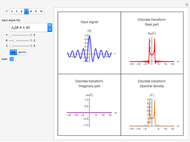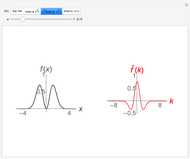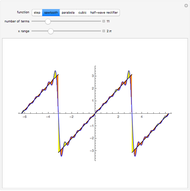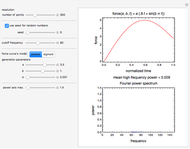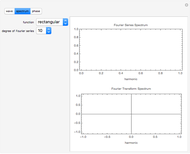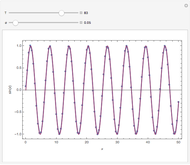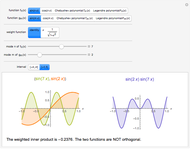Numerical Approximation of the Fourier Transform by the Fast Fourier Transform (FFT) Algorithm

Requires a Wolfram Notebook System
Interact on desktop, mobile and cloud with the free Wolfram Player or other Wolfram Language products.
The Fourier transforms of some classical functions are calculated and their real and imaginary parts are plotted. The Fourier transform (FT) is numerically calculated by using the step function approximation to the Fourier integral; this finally leads to the discrete Fourier transform (DFT).
[more]
Contributed by: Blazej Radzimirski (March 2011)
Open content licensed under CC BY-NC-SA
Snapshots
Details
The continuous Fourier transform (CFT) of a function  and its inverse are defined by
and its inverse are defined by

 InlineMathColumns=,Columns
InlineMathColumns=,Columns

 InlineMathColumns=.Columns
InlineMathColumns=.Columns
A numerical approximation of the CFT requires evaluating a large number of integrals, each with a different integrand, since the values of this integral for a large range of  are needed.
are needed.
The FFT can be effectively applied to this problem as follows. Let us assume that  is zero outside the interval
is zero outside the interval  . Let
. Let  be the sample spacing in
be the sample spacing in  for the
for the  input values of
input values of  , which are assumed to be centered at zero, where
, which are assumed to be centered at zero, where  is even. The values of
is even. The values of  and
and  are chosen at the beginning in this procedure so the range of the interval
are chosen at the beginning in this procedure so the range of the interval  is changing and depends on these parameters. The abscissas for the input data are
is changing and depends on these parameters. The abscissas for the input data are  ,
,  . Then we can write
. Then we can write

 InlineMathColumns
InlineMathColumns
 =
= InlineMathColumns=Columns
InlineMathColumns=Columns
 =
= InlineMathColumns=Columns
InlineMathColumns=Columns
 =
= InlineMathColumns=Columns
InlineMathColumns=Columns
 =
= InlineMathColumns=.Columns
InlineMathColumns=.Columns
We define  ,
,  . This is necessary for the above expression to be in the form of the DFT, denoted here by
. This is necessary for the above expression to be in the form of the DFT, denoted here by  :
:
 .
. .InlineMathColumns
.InlineMathColumns
The sample spacing (i.e., the resolution) of the result is fixed at the value  as soon as one specifies the number
as soon as one specifies the number  of sample points and their interval
of sample points and their interval  . The above definition of the DFT is equivalent to the Mathematica command Fourier[list, FourierParameters->{1,-1}].
. The above definition of the DFT is equivalent to the Mathematica command Fourier[list, FourierParameters->{1,-1}].
Usually, comparable sample spacing intervals in  and
and  are required. Then, one must put
are required. Then, one must put  , or
, or  . It is clear that if one wishes to obtain accurate, high-resolution results using this procedure, then it may be necessary to set
. It is clear that if one wishes to obtain accurate, high-resolution results using this procedure, then it may be necessary to set  very large.
very large.
More details can be found in D. H. Bailey and P. N. Swarztrauber, "A Fast Method for the Numerical Evaluation of Continuous Fourier and Laplace Transform," SIAM Journal on Scientific Computing, 15(5), 1994 pp. 1105–1110.
You can choose the number of data points  (an integer power of two) from the radio button menu. The appropriate value of the output sample interval
(an integer power of two) from the radio button menu. The appropriate value of the output sample interval  for a given
for a given  is displayed after choosing the input sample spacing
is displayed after choosing the input sample spacing  . To show the sample points in the initial function (every fourth sample point is showed) and that the CFT in this algorithm is obtained in the form of points, check "points".
. To show the sample points in the initial function (every fourth sample point is showed) and that the CFT in this algorithm is obtained in the form of points, check "points".
It is very convincing to fix a sample spacing  from the popup menu and decrease the number of sampling points
from the popup menu and decrease the number of sampling points  : you can then observe the deterioration of the accuracy of the Fourier transform.
: you can then observe the deterioration of the accuracy of the Fourier transform.
Permanent Citation








